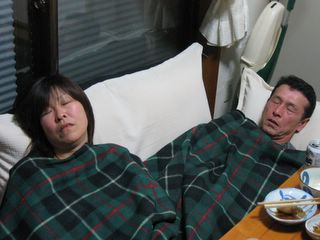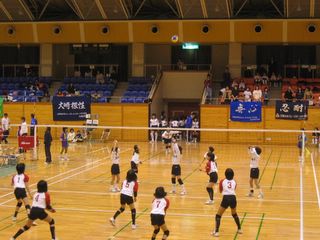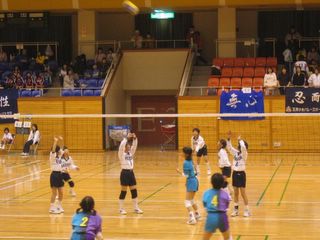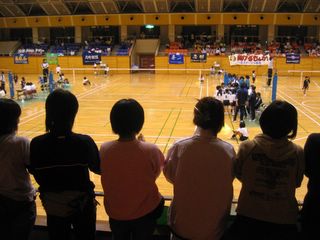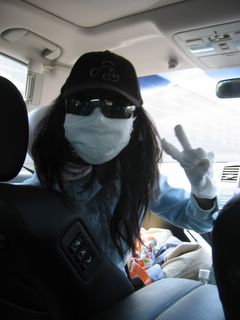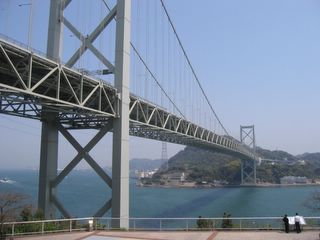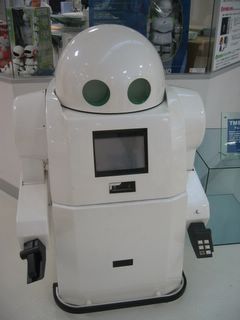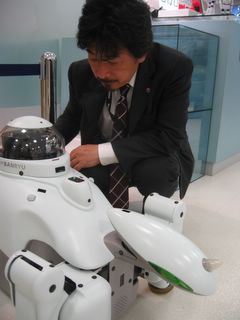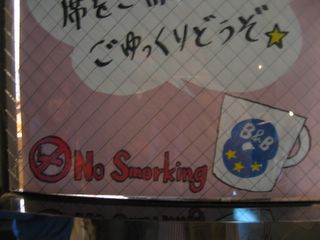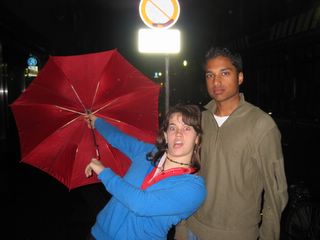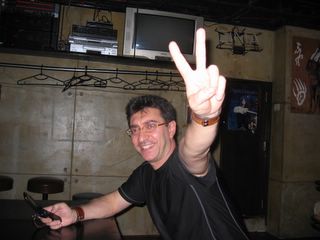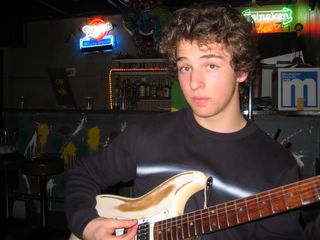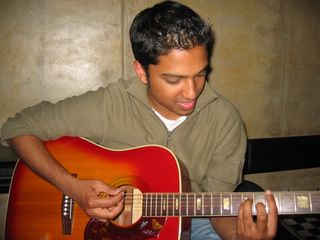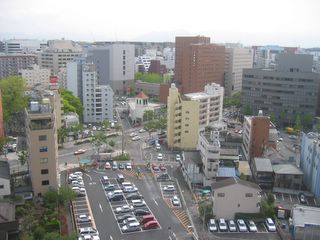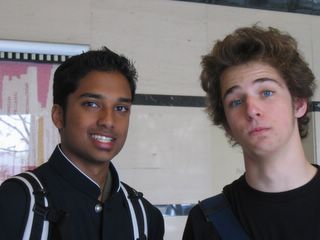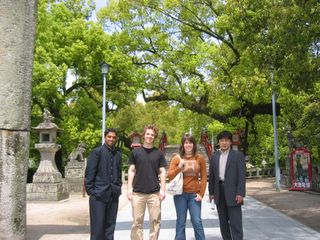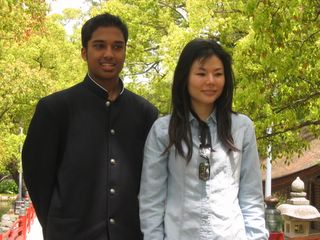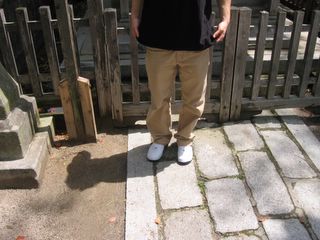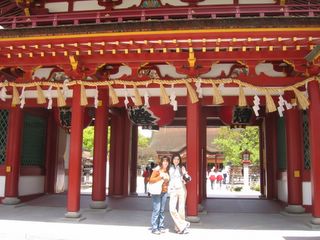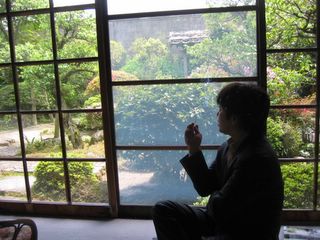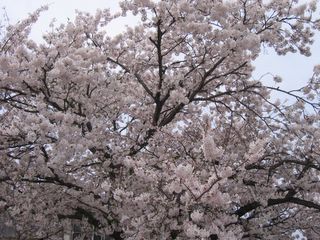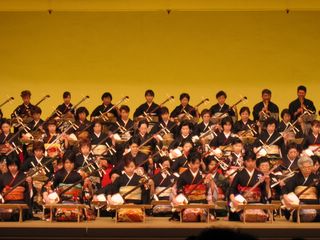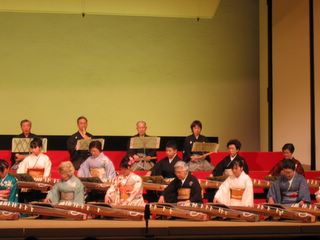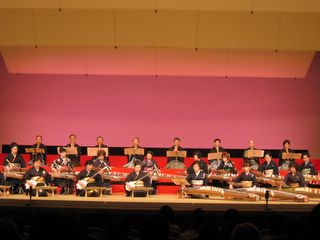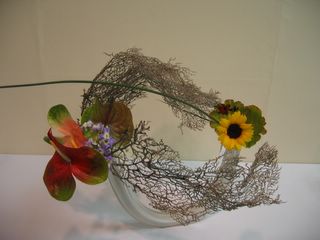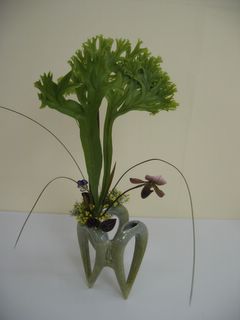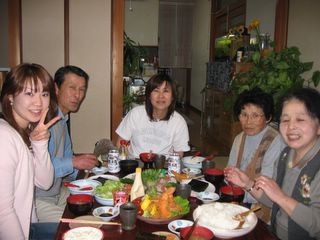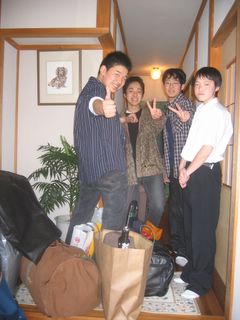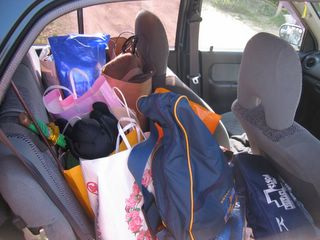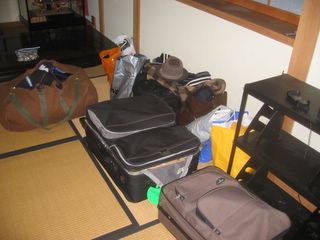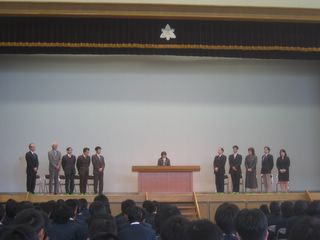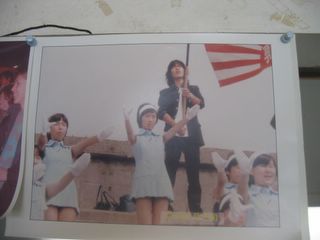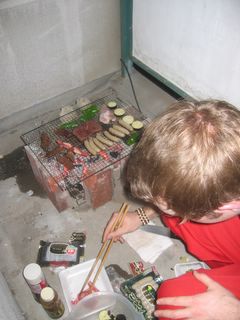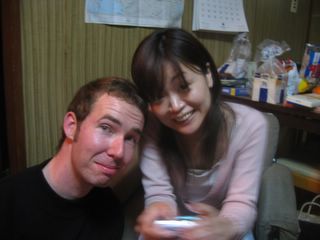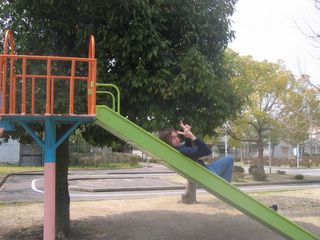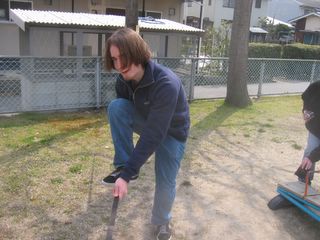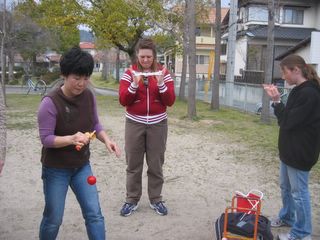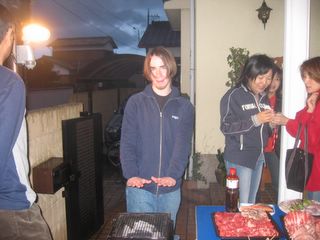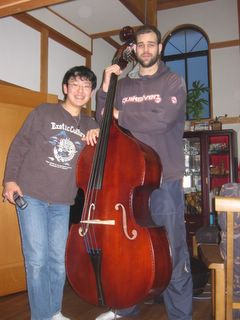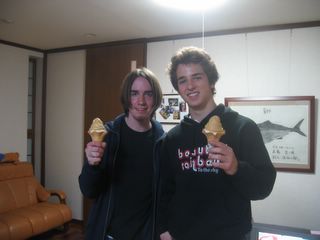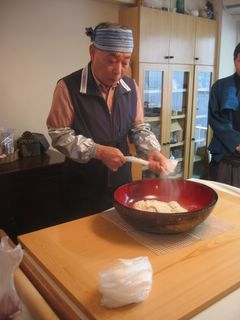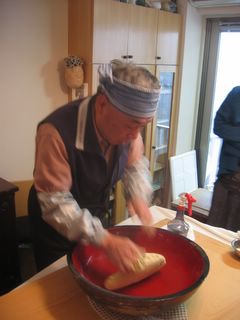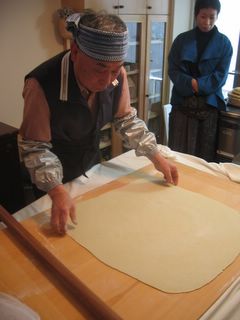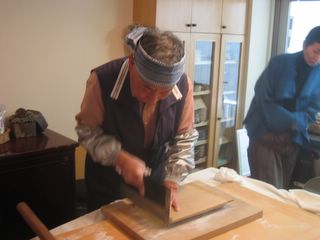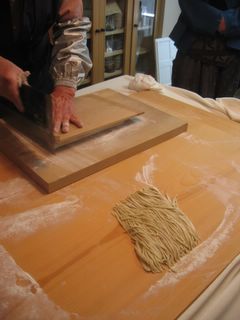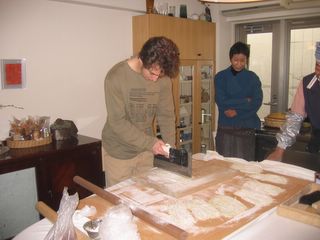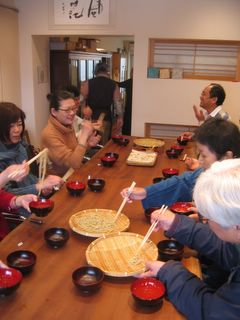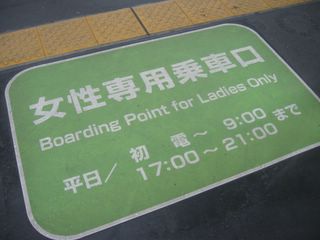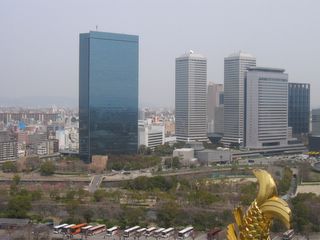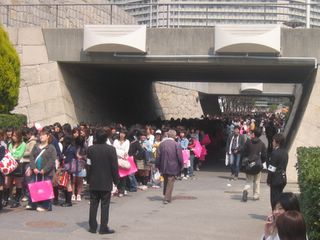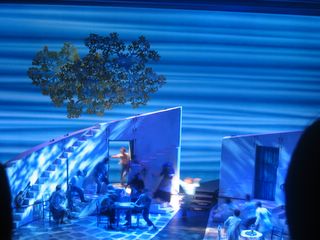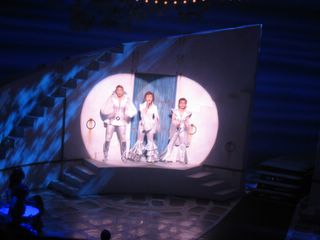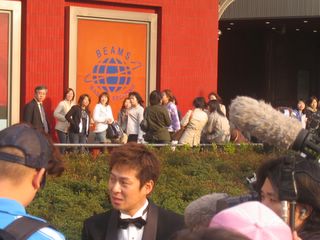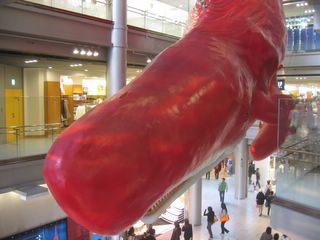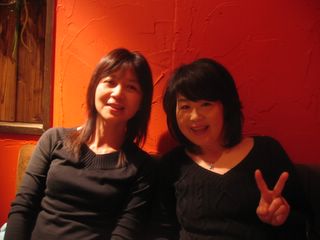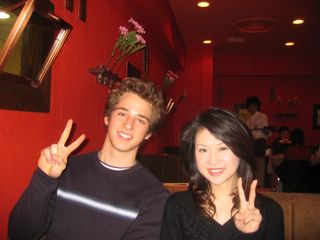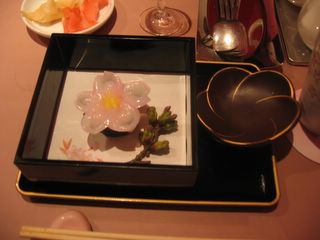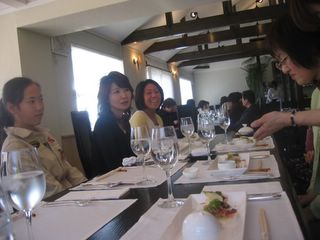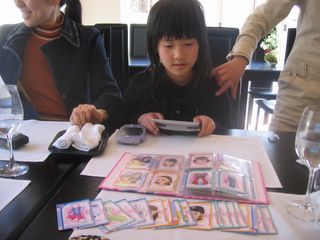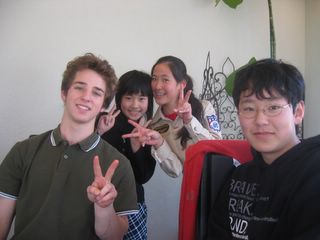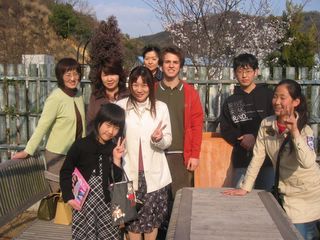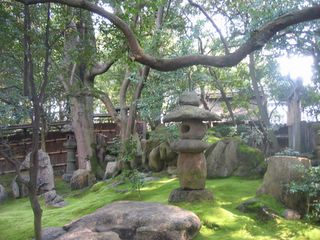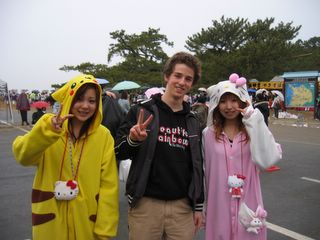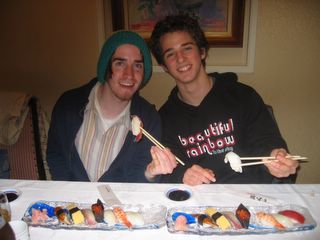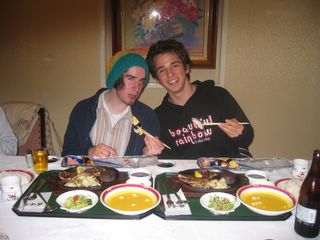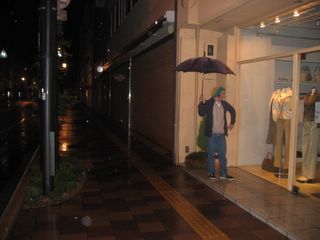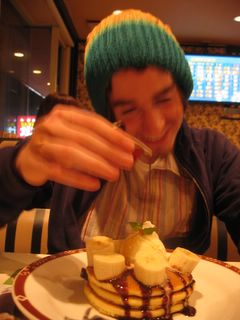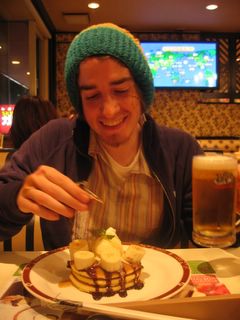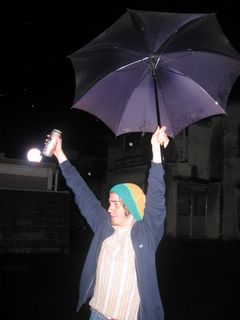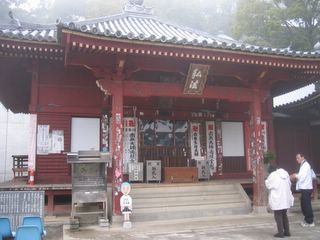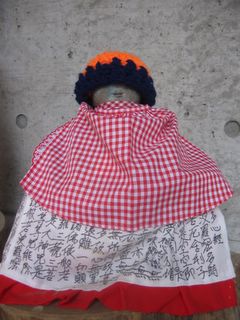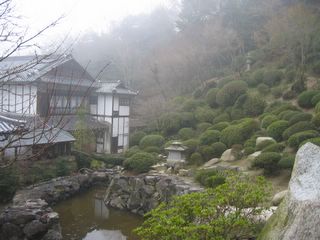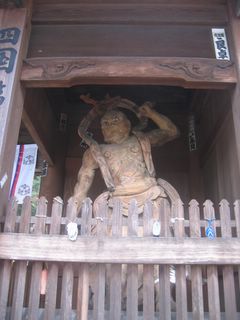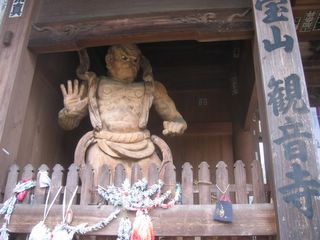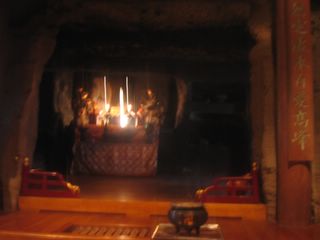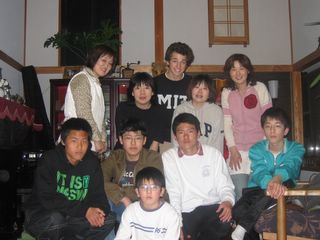4/28/2005
Bronze, Silver, and...
In other words, and barring physical injury, a journey to the heart of the Rotary Exchange Student Dream.
4/24/2005
On Any Given Sunday
I had the good fortune to experience one of these events “from the inside,” as it were, when my host mother coached the Hachihama Sho Gakko Volleyball Team at a qualification tournament this weekend at the Tamano Recreation Center. I entered the large complex to be immediately overrun by 4-foot tall girls in pigtails and knee pads, which I can equate only to crash-landing on Planet Cupcake in the Candyland Galaxy. I took my seat in the Hachihama section and let my vision blur as I absorbed the craziness of the scene.
Almost completely opposite from the sport of football, where standing next to players in 15-pounds of pads, helmets, and general body armor sends a shiver of fear down the spine, the volleyball girls exude an almost Rainbow Bright level of cuteness and appeal off the court. Yet when games are in session, the cute and cuddly disposition is all but disregarded as the girls become bloodthirsty bump, set, and spiking machines. Naturally, the nets are lowered and the volleyballs are more pint-size, but any of these girls could have taken my ass to the cleaners in a one-on-one game.
The only aspect scarier than the volleyball players on the court weren’t even participants themselves. They are the “Volleyball Moms,” cheering their offspring from a safe distance in the bleachers. You can be sure and spot these moms by their choice of waistline accessory, the fanny pack (something I thought went out of style with the Ring Pop and the Tamagotchi). Fanny packs are amazingly popular in Japan, especially among the “sporty” type, and come in many varieties (you’ll have to take my word for this, as I get enough stares already without photographing random women wearing fanny-packs from behind). Complete with entire sets of cheers, claps, and encouragement material to bark, bellow, and squawk at their children, the Volleyball Moms ensure no dull moment is to be had during the course of the game.
Despite the voracity of these moms they’re remarkably kind generous, often sitting beside or among moms from other teams (something I never found to be the case among American Soccer Moms, who always seem about an inch away from having their way with the opposing side using a broken beer bottle and a minivan). I found a seat behind the cheering moms, and waited for the first match to begin.
The girls spilled onto the court, practicing some warm-ups. I spotted my host mother giving slight direction, but for the most part the practice seemed autonomous. The girls eventually formed a line at the side of the court, bowed and shook hands with the opposing team, bowed to the referee, and donned their “Let’s Get It On” faces. Before the first serve, as well as every serve to come, the captain would shout something in a high pitched voice that the others on the team would then repeat. As the game progressed, and the girls fired shot after shot over the net (followed often by a bump, a set, and a spike), I started to notice a certain robot-like nature to the proceedings, much like Van Buren’s “Political Machine” of 1821. Imaginative and able to adapt, but in the end always keeping to the basics.
The Hachihama team did a good job of staying in the game, and as the score remained tied at 22, then 23, then 24 I regretted not taking a bathroom break before the action began. It was a true nail-biter, but a well-placed spike, slipping past Hachihama’s defenses, sealed the deal for the opposing team. It was a tough loss, but these Hachihama girls are from the streets, and the school of hard knocks, so it’ll take more than one loss to break their morale.
After the game I interviewed some of the players about their thoughts of volleyball, but their Pretty Princess responses of “fun” and “exciting” kept me from pressing the subject. I didn’t dare turn my back, though, lest a well placed spike make this 31st Annual Tamano Elementary School Volleyball Tournament my last.
4/21/2005
4/20/2005
Fukuoka on a Tuesday is Decadent and Depraved
“Jolted awake from the top of an unmade bed at 8 in the morning as Rahul buttons the high neck collar of his Fukuoka school uniform. Violent flashbacks of hurricane-like winds the night before, recommended Fukuoka microbreweries, and drinking rum at a place called “Beers.” Checking the phone messages and noticing many, I ask Rahul what’s going on with the state of the world. “There was an earthquake; I didn’t know what was going on.” The front desk of the hotel is on the intercom radio, blaring in Japanese. Elevator out of order, I’ll have to use the stairs from the 13th floor. Just like a bad movie.
How did I end up in an unkempt bed clutching a bottle of green tea for dear life, nerves recovering from the shock of being wired to the limit of sensory perception? My eyes focus on the New Testament, found even here in the Washington Hotel, placed by the ever present yet mysteriously shrouded “Gideons.” Who are these hotel-frequenting religious wraiths?
Luke 11:25 “And when he comes, he finds it swept and put in order.
This hotel room will not be seeing a state of order within the next few hours, especially following a mind-bending Tuesday night spilling my way down the street with my attorney, Rahul (a large 300-pound Samoan), and Janna (an innocent bystander we dragged along for the evening).
That damn elevator announcement again, broadcast to all rooms by a phantom speaker system embedded in the walls. Half a mind to ride that bastard straight to the bottom and fill the concierge’s face full of mace. At least until he’s “prim and proper” at this hour in the morning.
Rahul washes his face while I lay paralyzed on the bed. More flashbacks; playing guitar with a man from Tehran who has lived in Japan for over 22 years. He studied Psychology at Tehran’s “second strictest university” but now happily runs a hard rock bar called the “Black Shark.” Check my wallet to find a fistful of “Free Charge Passes, open Friday and Saturday, 3:00 AM to late morning.” Love to meet again over whiskey tonics for a nice discussion if I’m not run out of the town by late afternoon. Another swig from the bottle of green tea while the god-damn message blares for a fourth time. I don’t need this sort of interruption anytime before noon. Rahul and I shake hands, and he exits the tousled hotel room. Best of luck at school.
Also in my wallet, the card of Yoichi Takamoto, president and founder of TMSUK, premier robotic design company of Kita-Kyushu. Ah yes, finally uncovering the reason I made the 6 hour road trip to Fukuoka. You can find Takamoto by following the sound of his muffler tip, straight to a kitted Subaru with an obvious pirate theme dominating the interior. He prides himself with the pirate image, expressed through the TMSUK company slogan, “Pirates of Roboticians.”
Simply judging by appearances, Yoichi would strike most as an unconventional inventor. His beard and goatee would be better accustomed to the captain of any scurvy brigadier flying the skull and bones on the high seas. But the pirate façade is not one of laziness; Takamoto has been a busy man, putting 13 robotic models on the production line in the last 10 years. Known as a major celebrity in Kita-Kyushu, Takamoto finds the location an excellent working environment thanks to the local government bill legalizing robots on public streets, a luxury specifically banned in other parts of Japan.
Takamoto got an odd start in the robotic field, originally majoring in Archaeology before eventually switching jobs completely to manufacture conveyor belts used in food production (he holds the patent for the world’s first detachable belt). While contemplating the efficiency of conveyor technology in the home, he made the obvious jump to personal robot appliances for household use.
Takamoto’s first robot, A/ TMSUK-1, strikes the viewer as an oversized Duplo toy. A secretarial robot with large, friendly eyes, it can escort visitors to various locations within a building then return to recharge its battery. Much has changed over the years, and the more recent robotic inventions from TMSUK include a rescue robot, the T-62, capable of lifting small cars and supporting the weight of a falling building. Controlled either remotely or by a human inside the hull of the robot, the T-62 looks a bit like “Short Circuit’s” Johnny 5. Or perhaps his older, bigger brother.
Takamoto’s most recent invention, in conjunction with Sanyo, is the “Roborior.” A house robot that can be controlled by phone, the Roborior can relay video to almost anywhere in the world. Using the phone as a joystick the robot can be guided with directional buttons on the keypad, enabling a traveling Japanese housewife in London to view the status of her Tokyo apartment thousands of miles and one major ocean away. The robot, about the size of a soccer ball, radiates a friendly glow reminiscent of the glow worm, with all the cuteness and appeal of a small pet (which may even invoke a feeling of love). Patented and overpriced love, but love nonetheless, brought to you by a Sanyo/TMSUK partnership.
Slip his business card back into my wallet, and snap back to the reality of the moment. From my 13th floor overlooking the city of Fukuoka, the hotel is racked from an aftershock of the earthquake. Stronger than I expected, but not a rare experience when it comes to Japan. Janna knocks on the door and enters the room while sirens whine in the distance. Good to know she survived the previous night, returning to her room sometime after sleep got the better of me.
A message from Rahul comes over the Mojo wire. All trains in the city have been stopped, massive crowds in the station. Looks like he’ll be taking a bus to school.
Janna returns to her room to pack; we’ll have to rush to catch the continental breakfast. The lifts are working by now, which is good news for all. Descending with my baggage in the elevator, I meet Janna on the bottom floor. From behind her comes Rahul, in school uniform, sweating after a run up 10 flights of stairs (he made it that far when they announced the lifts would begin operating again). He says all the busses have been rerouted to highways only, and perhaps his school has been cancelled. Looks like he will be bumming around with us for the day. Earthquake day. And just another Wednesday morning in Japan.”
4/18/2005
Welcome To Reality
This Saturday, following a late-night Hanami party at Miyama Park the night before, I had planned to go fishing with my host father and two if his friends. My host father owns a small boat and regularly goes fishing with friends from work to relax and enjoy the ocean air.
We left the house around three in the afternoon, drove to a nearby fishing supply shop for new lures, then swung by a Konbini to pick up onigiri and o-bentos for dinner on the boat. Arriving at the harbor I met my host father’s friend (Asamura-san, a fellow banker) and climbed aboard the SS Kondou.
We spent about an hour fishing off the coast of Tamano (with little luck) before receiving a call from another friend of my host father who has just come from work and was waiting for us at the harbor. Stowing our fishing poles and bait, my host father maneuvered the ship back to port to pick up our fourth companion who introduced himself as Yokogawa-san. We spoke for a while (he mentioned that I had met his wife at a volleyball meeting with my host mother the previous week) and exchanged general introductions. He asked me about my future, what I was doing in Japan, and if I enjoyed fishing.
In regard to fishing, to be honest, I can’t remember the last time I cast a pole into any body of water. I have vague memories of fishing in the pouring rain as a child, and also recall a mild phobia of spearing worms onto fish hooks (which may explain the lack of fishing experience). Nonetheless I was excited to take a fishing trip, if only to get out to sea.
Wind tearing through my hair on the warm afternoon, my host father navigated the boat to his favorite location near Naoshima Island. Using a depth meter we found the “perfect spot” and dropped anchor to keep us in the correct position. My host father handed me a pole, gave me a quick run-through on its operation, and left me to my own devices.
I didn’t have much luck for the first 30 minutes or so. My host father、on the other hand, caught about 5 fish while I tried desperately to mimic his motions. After receiving a few pointers from Yokogawa-san and my host father, I got the hang of the correct depth and motion I should use with the lures. Soon after, I felt the first nibble on the line and reeled in a medium sized fish to add to the collection below deck. For the next few hours we chatted, caught fish, and enjoyed the relaxation that is inherent within fishing as the sun set over the Inland Sea. The wind began to pick up, but everyone was wearing heavy windbreakers and didn’t seem to mind.
Between the hours of 5 and midnight, the four of us caught what I would assume to be between 50 and 60 fish. I contributed about 15 of those, including one instance where I caught two fish at once on the same line. I also caught a few small squid in a net which my host father cleaned, and I ate right on the spot (still wiggling slightly). A little after midnight we decided to pack up and call it a night.
While I was winding fishing line and stowing the fishing poles below deck, Yokogawa-san and Asamura-san began to raise the anchors out of the water. All of a sudden, Yokogawa-san fell onto my host father who was standing in the back of the boat near the engine. I though he might be having a heart attack, so my host father called an ambulance while I tried to clear a space on the boat for Yokogawa to lie down. He wasn’t conscious and I didn’t think he was breathing so Asamura-san cut the ropes attached to the anchors while my host father gunned the boat back to the Tai harbor.
I couldn’t find a pulse in Yokogawa’s wrist or neck, so Asamura-san tried to perform mouth-to-mouth. The boat was too cramped for CPR, and it was very hard to keep Yokogawa-san in an upright position because his muscles seemed very stiff. As we approached the harbor, I grabbed a headlamp and flagged down the ambulance. At that point my host father and his friend tied up the boat while I was left with Yokogawa-san. I still couldn’t feel a pulse but kept his head and chest elevated with whatever I could find until the men from the ambulance finally arrived with a gurney and portable defibrillator.
The paramedics had to cut off Yokogawa’s shirt and jacket to get the pads attached to his chest. The machine was flat-lined and showed no heartbeat, and kept scrolling the phrase “no shock advised” in English. The paramedics said he should be moved to the ambulance, so we quickly lifted the gurney off the boat.
My host mother arrived as the ambulance pulled away, and I could see the men attempting CPR through the back window. My host mother suggested we go home while my host father docked the boat and drove to the hospital. Back at home my host mother asked me a few questions then left for the hospital. Keiko was awake, even though it was very late, but I had a difficult time getting to sleep because I assumed Yokogawa-san was dead.
In the morning I awoke to find my host father downstairs. He looked as if he didn’t get much sleep, and told me that the paramedics were able to get Yokogawa’s heart started again in the ambulance on the way to the hospital. I don’t know much about his condition, but the doctors said they are hopeful that he will make a recovery. I was amazingly relieved, because I had assumed we didn’t make it to the harbor in time and Yokogawa-san had died in my arms.
It was certainly a tragedy, but I am glad that there were four of us on the fishing trip because with only three people it would have been much more difficult to navigate back to shore. The whole experience gave me quite a shock, with a stern realization of how quickly situations can change for the worse.
I will be visiting Yokogawa-san in the hospital soon to check on his condition but for now I can only hope that he will make a recovery. He was only 49 years old, and ten minutes before he collapsed I had no idea he was in any trouble.
I might be taking a break from any more fishing trips.
4/14/2005
Correct Orientation
My classroom also comes equipped with two new homeroom teachers. Yamasaki-sensei would make for the perfect Prohibition Era gangster with his slim facial features and pinstriped suit. Put a Tommy gun in his hands and you’ve got yourself a first rate Mugsy. Nomura-sensei, his apparent partner in crime, is new to Tamano High School. On the first day of class he was asked to tell a little about himself. He prefaced his personal introduction by stating his love for alcohol, and drew a likeness of his favorite shot glass on the board. He continued with an anecdote about drinking and driving, and then went on to describe his various trips outside of Japan, his family, where he currently lives, etc. A stark contrast from personal introductions in America, where even the mention of alcohol might put a damper on your teaching career. However, I found the speech rather informative (and probably more truthful). Two fine Senseis.
The rest of the day was business as usual. I have new teachers for Japanese Society, Chinese, and English, but I’m still waiting to see how the rest of the week will unfold. Judo class remains the same, but I have a different partner who weighs a good deal more than stick-like Fuminori who I was often paired with last year.
After school I found my way to the Kendo Jo for the first practice of the year. Sadly, the previous Kendo teacher, Sakaguchi-sensei (who had the best English of anyone I have met in Japan) retired last year. The new teacher, Ishii-sensei (I would soon come to discover) is a viable replacement. Although he speaks no English at all and appears to be between 55 and 60 years old, he is the craziest man I have ever seen with a bamboo sword in his hands. His high-pitched squeals of "Kote!" and "Men!" were enough to deeply frighten me, and he ended up pushing me all over the Kendo floor (giving me a workout I could feel for a few days).
Aside from school, the other activities for the week included a trip to Okayama where I happened to meet Saeki-san at a Shamisen concert. We then went to lunch with her sister and brother-in-law after viewing some lovely Ikebana on the 6th floor of the Tenmaya department store.
For the most part, I had forgotten how much time school seems to take out of my day. While I miss the solid month of waking up at the crack of noon, it is nice to see my friends again.
So far, I have discovered the bike ride to school lasts about 35 minutes (25 if I’m in a hurry) but isn’t very daunting. I will devote a later entry to the actual process of arriving at school due from Hachihama to its lengthy yet beautiful nature.
Until then, if you feel the need to reach me in Japan, direct your comments, concerns, and fan/hate mail to:
Raoul Duke
613-1 Hachi
Hachihama, Tamano 7060223
JAPAN
I am also able to receive mail at my previous three addresses.
4/10/2005
A Whole New World
The move from Kawai-san’s house was emotional (you grow rather attached to a family when you live with them for any amount of time), and after spending 100 days in Kawai-san’s house it was strange to see my bags packed and room clean (for once). Aketa-san came to help move my bicycle and large number of suitcases to Hachihama, and some of Tomoya’s friends also came to wish me goodbye (and rummage through my bags looking for exciting things to play with/break/ask to keep).
It was perhaps a little more difficult for Kawai-san when the time came for me to leave. I packed my bags into a new host mother’s car, and moved on to another exciting adventure in Japan while she had to wave goodbye. The night before I left we exchanged gifts from American and Japan (Tomoya, instead of the mayor of Tamano, ended up with the massive West Virginia flag), and she told me that she and her husband were taking a trip to Fukushima so she wouldn’t feel too sad. She also added that I could stop by anytime, especially to eat some of grandma Kawai-san’s delicious yaki-soba (an opportunity I fully plan to exercise).
Kondo-san, my new host mother, came to pick me up in a sporty green car decked-out with a variety of Snoopy dolls. We piled my suitcases into the back of Aketa-san’s truck, and shoved the remainder into the back of Kondo-san’s mini (I was surprised it could still move with all the weight).
I waved a final goodbye to my host family, and was soon on the road to Hachihama. First, a little bit about the location:
Hachihama, translated as “eight beaches,” is unique in that there are actually no beaches in the area (due to reclaimed land). The sea is very close, however, and I can reach it with a short bike ride from the house. Location-wise the house is reasonably far from civilization, but aside from distance there aren’t too many mountains separating me from the Hachihama bus station, Tamano High School, and Okayama (if I’m feeling adventurous on the bicycle). Also, the scenery is magnificent with a large mountain (Kinko-zan) rising from behind the house and rice fields stretching out toward the sea (last night I witnessed someone with a blowtorch burning old leaves in a field, a definite first since arriving in Japan).
The family of Kondo consists of my host father (Nobuharu), mother (Junko), sister (Nobuko), and dog (Boss). My host father works in a bank and is an avid fisherman (he owns a boat and has offered to take me to an island where the fishing is excellent). Junko-san works as a counselor for the Hachihama Middle School, but is also an ardent volleyball player and coach. Nobuko is a college student at Okayama University studying Intercultural Communications; a major that she says is difficult yet exciting. She has a part time job at a local café, and plans on becoming a flight attendant. She traveled to New Zealand to study English last year (although she couldn’t find any pictures of the trip aside from her host father giving the dog a bath) and plans to study in America (perhaps Miami) next year. The dog, Boss, is 14, friendly, and very fat.
After Kondo-san brought me back to the house, I was introduced to two more members of the family, Obaachan and Baba. Obaachan is Nobuko’s grandmother, but I have not yet discerned the relation of Baba (in Japanese “baba” translates as “old woman,” so I decided to simply leave it at that). They live in a large house adjoining Kondo-san’s, with a large Japanese garden that is shared between the two houses.
My first night, the whole family gathered for “maki-zushi,” a type of make-your-own-sushi, with fried shrimp and miso soup on the side. I showed my family pictures from America (slightly outdated by this time), and some more recent DVDs from Japan on the computer.
Pictures, as well as a more in-depth description of the house and surrounding area will come soon, but for now I can safely say I will have dedicated (high speed) internet access and computer, which leaves me feeling relieved.
For now, delicious smells are wafting from the kitchen, which requires my investigation.
4/8/2005
Time For A Change
As for the rest of Micah’s time in Tamano (and because of reasons I will explain later), I am going to let the pictures do the talking. I promise it was a fantastic end to spring break.
Speaking of which, it is finally spring here in Japan. A time of new beginnings, as they say. The Sakura are blossoming, the weather is peachy, and most everyone I’ve spoken with is in a friendly spring kind of mood. In that vein, I also started back to school today as a second year student (cheers!). Neil threw a small BBQ party at his house in celebration of Miwako’s new job at the Mitsui Shipyard, and it was a joyous welcome for the coming school year.
But now for some big news: This Saturday, I will move to my third (and final) host family in Hachihama. It is a fairly remote part of Tamano, and I doubt I will have computer or Internet access. I have been told, however, that I can play guitar in the forest to attract small woodland animals to my location. I might also start a regular meditation schedule. Who knows! I will eventually find a way to continue updating the blog, so bare with me while I “switch it up” with the host family.
All kinds of new experiences, and a little over three months left of my time in Japan. Until next time...
4/7/2005
And Then We Eat It
This weekend I received a summons to an “invitation only” Soba-making party held in Tamano. I was surprised by the offer but was thrilled with the opportunity to make some authentic Japanese noodles. I arrived around noon to find 10 people and the master soba chef talking in the main room of a small 2nd floor coffee house. Recently, I was featured in the Tamano City magazine as one of the “international visitors,” so some people commented that they had read the article when I introduced myself.
At first I was a little worried about barging in on the soba making process, but everyone at the party was quite talkative and friendly. The chef, and older gentleman who had been making and sampling soba for many years, gave a small introduction speech then got down to business. He combined a special wheat-flour with eggs and water, then kneaded the crumbly goat-cheese like mixture until a large round ball of dough formed. He then used a massive cutting board and wooden rolling pin to systematically flatten the dough to the thickness of a few millimeters. The dough was then folded into a small rectangle about the size of a college textbook.
Perhaps the most interesting step in the soba making process is the cutting of the noodles. This (along with slight ingredient variation) is what differentiates soba from other Japanese noodles (mainly ramen and udon). The soba chef pulled out a very large, very flat knife, and with the edge of a smaller cutting board as a guide began to slice the soba into thin lengths. When he was about finished, he asked me to give the slicing a try and I feebly wielded the large knife, cutting some decent looking lengths of dough.
As for the preparation/boiling of the noodles themselves, the chef recommended no more than 30 seconds of boiling time per portion of soba. He then insisted that the soba must be eaten within three minutes of boiling, else the soba lose its flavor.
Everyone in the coffee shop took a seat while the chef and his assistant (I believe it was his wife and daughter) boiled the soba and served the guests at the party. We first ate the noodles dipped in cold water, to get a better taste of the soba flavor, before moving on to soba dipped in soy sauce with wasabi on the side. After about 10 platefuls of soba had been passed around the table we finished the meal with some smoked fish and a thimbleful of sake (or two).
I didn’t think making soba could be such a social event, but I got to know a good deal about the other guests at the party. Following the soba making festivities, I procured the soba chef’s business card and returned home to clean up the house. Why the cleaning job? For one reason, my room was a disaster zone after a solid month of traveling, parties, and sleeping. But also because that evening Micah was coming all the way from Kanonji to visit Tamano for a few days. It was difficult to convince his host Rotary counselor to let him come, but after my host mother talked with him on the phone he willingly agreed to let Micah “out of the cage that is Shikoku” (my Rotary counselor, Aketa-san, had no problem with letting me travel to Kanonji, but perhaps because Kanonji is in the middle of nowhere, and Aketa-san is a cool guy).
Stay tuned for reggae, BBQs, and a little bit of bubble blowing.
4/6/2005
Retrograde Motion
However, while teaching English at a juku in Tamano, Micah and I came across the greatest Sony invention EVER, which somehow slipped through the cracks of time. It's called the "Sony Teaching Card Player," and for all I know it was only released in Japan sometime in the 80s or early 90s.
The device is about the size of a small lunchbox, and a little heavier than a briefcase. It comes with various cards fitted with magnetic stripes, which you place into the reader. The Card Reader then dictates a small passage written on the card, with the intention of teaching the listener simple English phrases.
Like the first person who realized a turn-table could be used for other uses than strictly record playing, Micah and I immediately "scratched" the cards through the reader. By the end of our five minute jam session, we were laughing too hard and had to give the machine back to Otani-san before we fell over and passed out.
I can't find any reference to the machine online, but I will be borrowing/stealing the card reader from Otani-san to lay down some dope tracks under the name "MC Sony Teaching Card Player."
Here are some samples (click for the video):

Instructional card: "I can run, I can run"

Instructional card: Woman singing, followed by "Sing"
Absolutely ridiculous, and just another reason I'm glad to be alive.
4/5/2005
Playground Osaka
I ended up riding the same bus with her to Okayama (which calmed my fears about a cruel April Fools joke), and we talked about what she had been doing recently as well as some general facts about Osaka. Apparently, Osaka is one of the fastest moving cities in the world, in league with Tokyo and New York. People walk faster in Osaka than other parts of Japan, and use the left side of the escalator for waiting and the right side for people in a hurry (the reverse is true for other cities in Japan). Shoko also informed me that she purchased a new TV, even larger than her old TV (which is the largest I have seen in a house in Japan), and invited me over anytime to sit and vegetate in front of the massive screen.
Arriving in Okayama, I treated Shoko to a breakfast at Starbucks, and then proceeded to the ticket counter for train tickets to Osaka. Boarding the Shinkansen, Shoko pulled out her new iPod mini (a birthday present from Masatoshi) and we both listened to some tunes on the speedy 44 minute ride from Okayama to Osaka.
Arriving in Osaka, it didn’t immediately appear different from any other Japanese city. I did notice the use of the opposite side of the escalator (very strange) and we boarded a train to Osaka-Jo Koen (Osaka Castle Park), our first destination before the show. I had visited Himeji and Okayama castles before, but the Osaka castle is the newest of the three (reconstructed in 1931). Striding across a large park near the station, we crossed a bridge and entered the grounds of the castle proper.
Osaka castle can be easily recognized as a Japanese castle from the multi-tiered roof and large protective stone walls. Osaka castle, to the best of my knowledge, was burned to the ground and rebuilt sometime before the Meiji Restoration. Shoko and I spent some time walking around in the interior of the castle, where I overheard a Hebrew-speaking couple but couldn’t remember enough conversational Hebrew for an intelligent conversation. The castle itself was a multileveled museum, with a large observation deck on the top floor. Many large and decisive battles in Japanese history had been fought at the site, and scores of artifacts had been collected at the museum.
After the castle, Shoko and I took a different path back to the station passing a considerable line of girls waiting for a Japanese boy-band concert at the Osaka Dome. They were all carrying pink bags, and some looked as if they had been waiting in line for a long time. Back at the station, Shoko and I bought a quick lunch before entering the Mama Mia concert music hall.
I didn’t know quite what to expect from Mama Mia. It is based on ABBA songs, which to me seems like it’s either going to be excellent or terrible, with little gray area in between. I have little knowledge of ABBA’s music (outside of Dancing Queen and the title track, Mama Mia), especially the Japanese versions. Entering the large concert hall, Shoko and I took our respective seats (she bought the tickets online, accidentally in separate rows). I noted very few men were in the auditorium, but the same might go for Mama Mia performances around the world.
To my wonderful surprise, from the time the curtain went up until it finally closed again after several bows, Mama Mia was amazing. The singing, dance numbers, and acting was so phenomenal that I didn’t even feel burdened with the task of translating the Japanese. The costumes were also astonishing, but maybe it has just been a while since I have seen a large-scale musical. The theatre group that put on the musical is also supposed to be one of the best in Japan, so I was thoroughly satisfied with the final product.
The story of Mama Mia is a simple one; a girl invites three of her mother’s childhood lovers to her wedding ceremony with the hopes of discovering her real father. Singing, dancing, and all around hilarity ensued, with ABBA oddly fitting for the occasion. At the end of the show the cast came out for a massive dance number, followed by three curtain calls and numerous rounds of applause.
After the musical, and thanking Shoko profusely for the tickets, we met her friend Kishi-san and daughter Hiroko before going to dinner at “Creative Sushi” near Osaka station. Kishi-san is a pharmacist, and her daughter is currently studying medicine in Osaka. On the way to Creative Sushi, I received the shock of the day by running into Andee’s host family from Tamano. Out of the countless number of people in Osaka that day, what are the chances of running into someone recognizable from Tamano? It was Andee’s host sister’s first day at college, and her mother had come along to help her move into the new apartment. We had a quick, shocked conversation before regaining composure and continuing to the restaurant.
Creative Sushi was certainly that, with about four courses of various sushi concoctions served, before being handed a menu with numerous sushi-of-the-day selections. I chatted with Hiroko, the college student, and Kishi-san about my stay in Japan, and then a little more in depth with Kiroko about college in Osaka. We laughed, ate sushi, and took pictures before finally returning to the station to say goodbye.
Back in Okayama, Shoko and I rode the train home together before I departed at Bizen-Tai station.
An excellent day in Osaka, and I would love the chance to visit again.
4/4/2005
Great Chefs, Electronic Devices
So when my host mother mentioned we were going out to lunch with a couple of her friends, and drove into the mountains near Yuga-san (the location of the fire-walking earlier this year), I never expected our final destination to be on par with “Great Chefs” type dining. The restaurant, called Felice, was nestled among the mountains of Japan and I doubt I could find the restaurant on my own if I tried again. It featured a lovely English garden and wonderful view from its top-secret location.
Accompanying us at the lunch was my host brother, about 5 of my mother’s friends from work, and two younger girls. Before our appetizers arrived, we went through the regular Japanese ritual of displaying our cell phones and eventually placing them on the table (as you would a pair of glasses). The two girls each pulled out Nintendo Gameboys (one a new DS, the other and older SP). But all electronics had the opposite effect of what I had expected. There was much conversation, and in fact the cell phones become conversational pieces in themselves as people snapped pictures and showed them to the guests at the party.
The foods at Felice were delicious, certainly meriting Benjamin’s Stamp of International Dining Approval. About halfway through the meal I received a call on my phone from Michiko in Tsuyama. Stepping out into the lovely English garden of Felice, she told me that her husband had arranged a meeting for me with the president of the company TMSUK, a major name in Japanese robotics which has various models currently on display at the World Fair in Aichi. I was floored, and she asked me if I was free on the 19th of April. The company is located in Fukuoka, so I might also get to see Rahul again before the end of my stay in Japan.
This news comes after being called randomly while I was in Kanonji by the husband of the president of the Okayama Institute of Languages to ask if I could have a meeting with him to discuss the new internet café he will be opening in Okayama during Golden Week. I met Katayama-san the following week in Okayama (he told me to call him Mr. K) and he asked me a few questions about my knowledge of internet cafés, blogging, and general internet related activity. I also met the head technician of the café, who was from China and only spoke Chinese and Japanese but we managed to have a relatively in-depth conversations about web serves despite the language barrier. Mr. K will be traveling to China and America this month (he also owns and oil company), but we arranged another meeting once the internet café opens in May.
After the meal at Felice, one of the girls pulled out a set of fancy looking cards with pictures of various clothing articles on each face. She explained that the game is currently very popular in Japan, and can be played at game machines in arcades all over Japan. The game involves interacting with a virtual manifestation of yourself, and then receiving a card with various dresses, shoes, hats, accessories, and hair styles with which you can augment and “pimp” your virtual character. All games are linked through the internet, so no matter where you play the game your character remains saved. The cards you receive can also be traded with friends, family, and strangers on the street for an eclectic mix of virtual and real-life game aspects. Yes indeed, Japan is very cool.
The following day I traveled with Shoko to Osaka, but for the sake of partition I will leave it for another entry.
4/1/2005
Shikoku Excursion and the Difficulties of Being Threadbare

That’s right kids; I just repaired a large gash in the sleeve of my sweater with my own two hands, a needle, and some thread. I haven’t accomplished anything this great in the area of arts, crafts, and homewares since the legendary model car track made of magazines, newspapers, and wood that rocketed toy wind-up cars off my bed, into the hallway, down a large flight of stairs and out the front door with speed, accuracy, and frightening efficiency. Truly, that thing worked like gangbusters. But this sewing accomplishment blows that creation right out of the water. Sure, I could have left the gash in my sleeve. In fact at an Osaka shopping mall I spotted a “made to order” jeans location where you can select (from a menu) various cuts, burns, and patches that make your jeans not only unique, but also removes the hassle of actually getting some use out of the jeans because they unravel and fall right off on the street. Betty Ross may have created the spirit of America by (supposedly) sewing the American Flag, but I have resurrected the American soul with some blue thread and a little ingenuity.
Then again, perhaps that is a little exaggeration. I am, however, always ready for a deal. In Tsuyama I made sure to visit my favorite awesome clothes discount store, Mate. You might remember the picture of my spanking new jacket I purchased from that location. In truth I didn’t really like the jacket, but I was only $3. You can’t beat that with a stick! And deals like that certainly don’t come often. In fact, I would challenge anyone who happens to stumble upon this blog to go and find a three-dollar jacket of similar quality and style. You can’t do it! And if you can prove me wrong I will totally* send the three dollars required to purchase the jacket of your choosing (of equal of lesser three-dollar value). Send self-addressed stamped envelope to:
Three-Dollar Jacket Happy Challenge Contest Japan
C/o Benjamin Gleitzman
3-18-39 Tai
Tamano, Okayama 7060001 JAPAN
*Disclaimer: this contest is coming from someone who, at an early age, once poured an entire box of Cheerios on the living room floor and with a straight face told my father, “I don’t know who did it, but it wasn’t me.” I don’t think he has ever trusted me since.
With that out of the way, and still feeling quite excellent about the sewing of the sweater, a recap of the last few days.
This weekend I took a trip to visit my good friend Micah in Kanonji. Kanonji is a very small town on the island of Shokoku, with various tourist attractions but actually (Micah tells me) very little to explore entertainment wise. Micah, who I learned has apparently been living “Fear and Loathing in Tokushima” over the past week of spring break, spent most of the morning with me telling stories back and about our various Japanese adventures. I’ve traveled a lot of places, but his weekend in Tokushima probably trumps every exchange student’s story on Shikoku, and perhaps the entire southern part of Japan. No kidding.
But my real reason for coming to Kanonji was the 50th anniversary festival being thrown in the town. Micah said that flyers had been posted in train stations and bus stops as far away as Takamatsu, so I was expecting some craziness. There was a little rain that day, but I was very impressed with the large amount of “chosas” present at the festival. Chosa can be translated as “portable shrine,” and most of the festival was centered around the 30 or 40 drunk men per chosa lifting them high into the air. Micah and I found some of his schoolmates as well as girls dressed in Hello Kitty and Pikachu costumes before striking out on our own into the crowd in search of excitement. To our dismay, the festival ended around 4:30 so we accompanied the parade of chosas back toward Micah’s house.
That night Micah’s host father, who is head of the Rotary club in the area, took us to an amazing dinner at a nearby Hotel with some family relatives. Micah’s host father can be very difficult to understand, and in fact I admire Micah for doing his best to live a peaceful life in their household. The problem is that Micah’s father speaks “Sanuki Ben,” a sort of obscure and heavy dialect of Japanese whose name comes from the old word for Kagawa, “Sanuki.” He also mumbles, which does not help the situation. As a result he ends up sounding like a Japanese Ozzy Osbourne with broken, often incomprehensible statements, grunts, and whistles (okay I made that part up). But he was an excellent guy so I can’t fault him there.
At the restaurant, steak and sushi were on the menu as well as anything else we cared to order. Excellent conversation and displaying of the day’s photos occurred throughout the meal, and we returned properly stuffed to Micah’s house.
That evening Micah played me a ton of Japanese cd’s that I had never heard before. It’s sad to say but the best resource of Japanese music to date has come from Micah, who lives in Ohio. Following the Japanese jam session we played some electric guitar, told more stories, walked around the town for a while, and fell asleep to the smooth sounds of Miles Davis.
The next morning (or early afternoon, to be exact) Micah’s host mother made a very large breakfast after which Micah’s father and a friend took us on a grand tour of Shikoku. Our first destination was perhaps Kanonji’s most famous tourist attraction, the Zenigata Sand Coin. It is a massive coin, sculpted in sand on the beach of Kanonji that we viewed from a nearby mountain. The sheer size of the coin was amazing, even though there was heavy fog that morning and I had a difficult time seeing the entire coin in the distance. I could feel it’s presence, spread upon the beach like an ancient crop circle. Thought to have been sculpted in 1633, the coin is cleaned and maintained every year by Kanonji residents and high school students.
Our next destinations were a few of the 88 Temples of Kobo Daishi, who you should remember from my last trip to Konpira-san. Many people make the pilgrimage to all 88 Temples on foot, a journey that takes about two or three months to complete. I found the three temples that we attended to be quite beautiful, although one looked very new and was made of concrete because the original temple has been blown down during one of the recent typhoons. I would not mind making the journey on foot to at least a few of the temples scattered around Japan.
We then stopped at a Hotel owned by a rotary member for some coffee and a small chat. I had to take a train back to Tamano, so we quickly grabbed some Sanuki Udon, famous in that area of Kagawa, and I walked with Micah back to Kagawa station before saying goodbye. On the whole even though the festival wasn't that eventful I toured some excellent places and has a super time sharing stories with Micah, and would be happy to return again to Kanonji.
